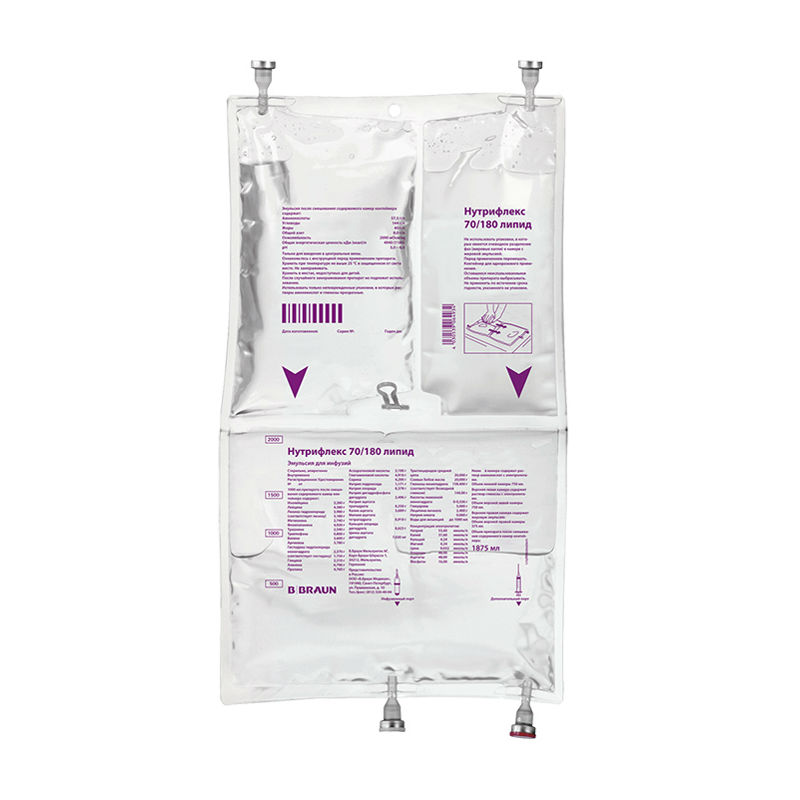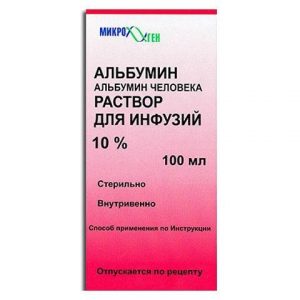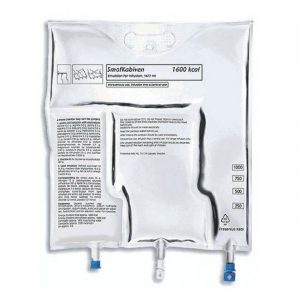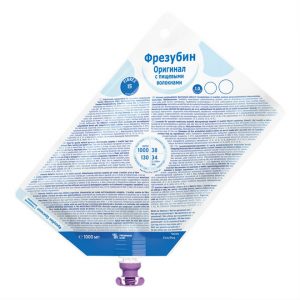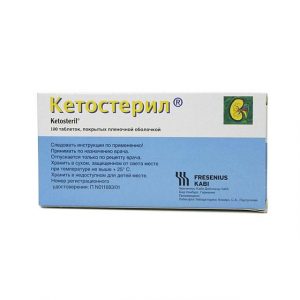Description
Release form
Emulsion for infusion
Packing
Container 1875 ml.
Pharmacological action of
Therapeutic action of
The objective of parenteral nutrition is to supply the body with all the necessary nutrients for tissue growth and regeneration, as well as energy, necessary to maintain all body functions.
In this case, amino acids are the most important, since some of them are indispensable in protein synthesis. The joint introduction of energy sources (carbohydrates and lipids) is necessary to avoid the undesirable use of amino acids as an energy substrate.
Glucose is utilized by all tissues in the body. For some tissues and organs, such as the central nervous system, bone marrow, red blood cells, renal tubule epithelium, glucose is the only source of energy. In addition, glucose is a material for the construction of various cellular structures.
Lipids have a high energy value and are also a source of essential fatty acids for the synthesis of cell structures and prostaglandins. To this end, the fat emulsion contains medium and long chain triglycerides (soybean oil).
Medium chain triglycerides are more rapidly hydrolyzed, eliminated from the bloodstream, and completely oxidized compared to long chain triglycerides. They are the main energy substrate, especially when the metabolism and utilization of long chain triglycerides are disrupted, for example, with a lack of lipoprotein lipase and / or lipoprotein lipase cofactors. Unsaturated fatty acids, which are part of long chain triglycerides, are used in the body mainly for the prevention and treatment of the lack of essential fatty acids and only secondarily as an energy source.
Contraindications
The drug should not be prescribed in the following conditions:
Identified hypersensitivity to egg or soybean protein, peanut butter or any of the components of the drug
Congenital disorders of the amino acid metabolism
High metabolic metabolism srdl severe post-aggressive syndrome, decompensated hyperglycemia in diabetes mellitus, metabolic acidosis, coma of unknown etiology i)
Severe hyperglycemia, uncorrectable with insulin doses up to 6 units / h
Intrahepatic cholestasis
Severe hepatic failure
Severe renal failure in the absence of renal replacement therapy
Progressive hemorrhagic diathesis
Acute myocardial infarction, myocardial infarction,
General contraindications for parenteral nutrition:
Unstable, life-threatening circulatory disturbance (collapse and shock)
Severe tissue hypoxia
Hyperhydration conditions
Disruption of water-electrolyte balance
Acute pulmonary edema Decompensated srdl.
Caution
Caution should be exercised when increasing serum osmolarity. Given the possible risk of volume overload when using Nutriflex 70/180 lipid, caution should be exercised in patients with impaired heart or kidney function.
The drug should be administered with caution to patients with impaired fat metabolism (for example, with renal failure, diabetes mellitus, pancreatitis, impaired liver function, hypothyroidism with hypertriglyceridemia and sepsis). In these conditions, monitoring the concentration of serum triglycerides is mandatory.
Special instructions
If anaphylactic reactions such as fever, cramps, rash, or shortness of breath occur, the infusion should be stopped immediately.
Violations of the water-electrolyte balance or acid-base state, for example, hyperhydration, hyperkalemia, acidosis should be corrected before the start of the infusion.
Too fast administration can lead to fluid overload with impaired electrolyte balance of blood plasma, hyperhydration and pulmonary edema.
With the introduction of Nutriflex 70/180 lipid, it is necessary to control the concentration of plasma triglycerides.
In patients with suspected impaired fat metabolism, there should not be hyperlipidemia when prescribing the drug. The introduction of fats with hyperlipidemia is contraindicated. Hypertriglyceridemia 12 hours after the administration of the drug indicates a violation of the metabolism of fats.
Depending on the patient s metabolic state, transient hypertriglyceridemia may develop or the concentration of glucose in plasma and blood may increase. If the plasma triglyceride concentration during lipid administration exceeds 3 mmol / L, it is recommended that the infusion rate be reduced. If the concentration of triglycerides in the plasma remains above 3 mmol / l, administration should be suspended until the concentration of lipids is normalized.
When increasing the concentration of glucose in the blood over 14 mmol / l (250 mg / dl), a dose reduction or stopping the infusion is necessary.
Like other carbohydrate-containing drugs, the administration of Nutriflex 70/180 lipid can lead to hyperglycemia. It is necessary to control the concentration of glucose in the blood. In the case of hyperglycemia, the rate of infusion should be reduced or insulin should be prescribed.
Intravenous administration of amino acids is accompanied by increased excretion of trace elements in the urine, especially copper and zinc. This should be taken into account when prescribing trace elements, especially with prolonged parenteral nutrition. Resuming or administering parenteral nutrition in malnourished patients, or in patients who have not received adequate nutrition, can cause hypokalemia, hypophosphatemia, and hypomagnesemia. An adequate introduction of electrolytes is necessary in accordance with deviations from normal values.
It is necessary to control the concentration of blood plasma electrolytes, fluid balance, acid-base state, blood urea nitrogen and, with prolonged administration, the cellular composition, blood coagulation system and liver functions. The type and frequency of laboratory tests depends on the general condition of the patient.
The drug should not be administered through the same transfusion systems simultaneously, before or after the introduction of blood due to the risk of pseudoagglutination.
May require replenishment of electrolytes, vitamins, and trace elements. The fat content in the preparation may decrease the accuracy of laboratory tests (for example, bilirubin, lactate dehydrogenase, oxygen saturation) if blood samples are taken during or immediately after the end of the drug infusion.
The infusion of Nutriflex 70/180 lipid, as with all intravenous drugs, must be carried out under aseptic conditions.
Nutriflex 70/180 lipid is a complex preparation. Therefore, it is not recommended to add other solutions to it without special indications.
The emulsion should be used immediately after mixing, or it can be stored at a temperature of 2-8 ° C for 4 days, and for an additional 48 hours (including infusion time) at a temperature of 25 ° C.
If filters are used during drug administration, they must be greaseproof.
After accidental freezing, the drug should not be used.
Use only intact packaging in which the solutions of amino acids and glucose are clear. Do not use packaging, in which, after shaking, the apparent phase separation (fat droplets) in the chamber with the fat emulsion is preserved.
Stir before use.
Single use container. The remaining unused volumes of the drug are subject to destruction.
Effect on the ability to drive vehicles, mechanisms
The drug does not affect the ability to drive vehicles, mechanisms, as well as engage in potentially hazardous activities that require an increased concentration of attention and speed of psychomotor reactions.
Composition
1 l
isoleucine 3.28 g
leucine 4.38 g
lysine (in the form of hydrochloride) 3.18 g
methionine 2.74 g
phenylalanine 4.92 g
threonine 2.54 g srdlprrd 3.75 srdlpk trrd75 g
glycine 2.31 g
alanine 6.79 g
proline 4.76 g
aspartic acid 2.1 g
glutamic acid 4.91 g
serine 4.2 g
sodium hydroxide 1.171 g
sodium chloride 0.378 mg
gg sodium dihydrate 0.2 gd sodium phosphate dihydrate 0.278 potassium acetate 3.689 g
magnesium acetate tetrahydrate 0.91 g
calcium chloride digi Rat 0. 623 g
zinc acetate dihydrate 7.02 mg
medium chain triglycerides 20 g
soybeans oil 20 g
dextrose (in the form of a monohydrate) 144 g
The emulsion after mixing the contents of the container chambers contains:
srdkrd amino acids 40g srd total nitrogen 8 g
Energy value:
amino acids 936 kJ (224 kcal)
carbohydrates 2412 kJ (576 kcal)
fats 1592 kJ (380 kcal)
non-protein energy value 4004 kJ (956 kcal) srdlk80 kcal)
Electrolyte concentration:
sodium 53.6 mmo l
potassium 37.6 mmol
calcium 4.24 mmol
magnesium 4.24 mmol
zinc 0.032 mmol
chlorides 48 mmol
acetates 48 mmol
phosphates 16 mmol
Excipients
citric acid monohydrate 0-0.336 g,
glycerol 5 g,
egg lecithin 2.4 g,
sodium oleate 0.06 g,
water d / u – up to 1000 ml.
Osmolality: 2090 mOsm / kg.
pH: 5.0 – 6.0.
Dosage and administration
Dosage
Intravenous administration only to the central veins.
The temperature of the emulsion to be introduced should be at room temperature.
The configuration of Nutriflex 70/180 lipid chambers allows the addition of a fat emulsion last, in order to preliminarily evaluate the compatibility with other added drugs.
Method of mixing the contents of the chambers of the
container If you need to add other drugs to Nutriflex 70/180 lipid, use the following method:
1. Remove the secondary plastic bag from the container, unfold and lay the container on a firm, level surface (on the table)
2. With two hands, press on the upper left chamber of the container (containing glucose solution with electrolytes), destroy the partition separating it from the lower chamber (containing amino acid solution) with electrolytes)
3. If necessary, add electrolytes, trace elements and other compatible medications (including water-soluble vitamins) through an additional port with a red protective cap
4. Above Viv both hands right on the upper container chamber (containing fat emulsion), destroy partition separating it from the lower chamber
5. If necessary, add the fat-soluble vitamins through an additional port with red
protective cap 6. Gently mix the contents of all container chambers.
If there is no need to add other drugs to Nutriflex 70/180 lipid, use the following procedure:
1. Remove the secondary plastic bag from the container, unfold and lay the container on a firm, level surface (on the table)
2. Push the two upper hands with two hands container chambers, destroy the partitions separating them from the bottom
camera 3. Gently mix the contents of all container chambers.
For infusion after mixing the contents of the container chambers:
After moving the emulsion to the lower chamber, fold the container in the middle. lines separating the empty upper chambers from the lower
Hang the container on the infusion stand by the special ring in the center of the
container. Remove the white protective cap from the infusion port, connect the intravenous infusion system and start the infusion at the speed specified in these instructions for use.
Doses:
are selected according to individual needs.
Children over 14 years of age and adults
The maximum daily dose is 35 ml / kg body weight, which corresponds to
2.0 g of amino acids / kg body weight / day,
5.04 g of glucose / kg body weight / day, 1.4 g fat / kg body weight / day.
Children 2 to 14 years old
These recommendations are based on average needs. The dose should be individually adapted depending on the age, stage of development and severity of the disease. To calculate the dose, the degree of hydration of pediatric patients must be taken into account.
For children, it may be necessary to start nutritional therapy with half the estimated dose. The dose should be increased to the maximum stepwise in accordance with the individual metabolic capabilities of the body.
For children from 2 to 5 years old, the daily dose is 25 ml / kg body weight, which corresponds to
1.43 g amino acids / kg body weight / day,
3.60 g glucose / kg body weight / day, -1.0 g fat / kg body weight / day.
For children from 5 to 14 years old, the daily dose is 17.5 ml / kg body weight, which corresponds to
1.0 g of amino acids / kg body weight / day,
2.52 g of glucose / kg body weight / day,
0 7 g of fat / kg body weight / day.
Due to the age-related characteristics of children, Nutriflex 70/180 lipid may not fully satisfy the energy requirement. In these cases, a glucose solution or a fat emulsion may be added to the parenteral nutrition program as necessary.
Speed ??of administration
Long-term administration of Nutriflex 70/180 lipid is recommended. A stepwise increase in the infusion rate during the first 30 minutes reduces the incidence of possible complications.
Maximum infusion rate -1.7 ml / kg body weight / h, which corresponds to
0.1 g amino acids / kg body weight / h,
0.24 g glucose / kg body weight / h,
0.07 g fat / kg body weight / h.
For a patient weighing 70 kg, the maximum infusion rate will be 119 ml / h. In this case, the rate of introduction of amino acids will be 6.8 g / h, glucose – 17.1 g / h, fat – 4.8 g / h.
Maximum energy intake should not exceed 40 kcal / kg body weight / day. In special cases (for example, for patients with burns), an increase in this indicator is possible.
Elderly patients
Doses do not differ from those recommended for other adult patients. However, metabolism can vary significantly in old age, so careful monitoring of this group of patients is necessary.
Patients with renal and / or liver failure
Doses are selected individually.
Duration of use
Duration of use of Nutriflex 70/180 lipid is not limited. With prolonged use, it is necessary to add the appropriate amounts of trace elements and vitamins.
Side effects
Adverse adverse reactions are listed below in organ systems and frequency of development. Most of the adverse side reactions associated with the use of this drug rarely develop (? 1/10000 – <1/1000). The following classification of adverse reactions by developmental frequency is used: Very frequent (? 1/10) Frequent (? 1/100, <1/10) Infrequent (? 1/1000, <1/100) Rare (? 1/10000, < 1/1000) Very rare (? 1/10000) Disorders of the blood and lymphatic system Rare: hypercoagulation. Immune system disorders Rare: allergic reactions (eg, anaphylactic reactions, skin rash, swelling of the larynx, mouth, and face). Metabolic and nutritional disorders Very rare: hyperlipidemia, hyperglycemia, metabolic acidosis. The frequency of these adverse adverse reactions is dose dependent and may be higher in case of lipid overdose. Disorders of the nervous system Rare: drowsiness. Vascular disorders Rare: increase or decrease in blood pressure, hot flashes . Disorders of the respiratory system, chest and mediastinal organs Rare: shortness of breath, cyanosis of the skin. Disorders of the gastrointestinal tract Infrequent: nausea, vomiting, loss of appetite. General disorders and disorders at the injection site Frequent: irritation of veins, phlebitis or thrombophlebitis may develop after a few days of using the drug. Rare: headache, fever, sweating, feeling cold, chills, pain in the back, bones, chest, and lumbar region. Very rare: fat overload syndrome. In the event of adverse adverse reactions, the infusion should be stopped or, if necessary, continued at a lower dose. With repeated administration, especially at the beginning of the infusion, careful monitoring of the patient’s condition is required. Blood plasma triglycerides should be monitored at increased intervals. Additional information about some adverse side reactions Nausea, vomiting, lack of appetite and hyperglycemia are symptoms that are the basis for prescribing parenteral nutrition or are often found in patients who are shown parenteral nutrition. Fat overload syndrome Impaired triglyceride utilization, which may be caused by an overdose, can lead to fat overload syndrome. Monitoring should be done to detect symptoms of metabolic overload early. Fat overload syndrome may be of genetic etiology (individual differences in metabolism), in addition, existing or transferred diseases can affect fat metabolism. This syndrome can also develop in the presence of severe hypertriglyceridemia, even if the recommended rate of infusion is observed, and also against the background of the development of severe complications, such as renal failure or infection. Fat overload syndrome is characterized by hyperlipidemia, fever, fatty infiltration, hepatomegaly (with or without jaundice), splenomegaly, abdominal pain, anemia, leukocytopenia, thrombocytopenia, impaired blood coagulation, liver hemolysis and reticulosis. Symptoms are reversible and usually disappear after stopping the infusion. In case of signs of fat overload syndrome, the administration of Nutriflex 70/180 lipid should be stopped immediately. Overdose of No overdose occurs when the drug is prescribed correctly. Symptoms of volume overload or overdose of electrolytes Hypertensive hyperhydration, electrolyte imbalance, pulmonary edema. Symptoms of an overdose of amino acids Loss of amino acids by the kidneys with the development of amino acid imbalance, metabolic acidosis, nausea, vomiting, tremor. Symptoms of glucose overdose Hyperglycemia, glucosuria, dehydration, serum hyperosmolarity, hyperglycemic or hyperosmolar coma. Symptoms of lipid overdose, Lipid overdose can lead to the development of fat overload syndrome. Therapy In cases of symptoms of overdose, the drug should be discontinued. Further therapy is selected individually depending on the severity of the symptoms. Infusion may be resumed later at a slower rate with constant monitoring. The concentration of triglycerides in blood plasma during infusion should not exceed 3 mmol / L. Interactions with other drugs Potassium-containing solutions should be administered with caution to patients who receive drugs, increasing serum potassium concentration, for example, potassium-sparing diuretics, ACE inhibitors, cyclosporin and tacrolimus. Soybean oil contains vitamin K1 which can interfere with the therapeutic effect of indirect anticoagulants – coumarins derivatives. Therefore, the therapeutic effect of indirect anticoagulants – coumarin derivatives should be carefully monitored. Corticosteroids and corticotropin cause sodium and fluid retention in the body. Some drugs, such as insulin, can interact with lipolytic enzymes in the body. However, these interactions are of little clinical significance. Administration of therapeutic doses of heparin leads to an increase in plasma lipolysis, which in turn can lead to a decrease in the clearance of triglycerides. Nutriflex 70/180 lipid contains zinc and magnesium, what should be considered when prescribing other drugs containing these trace elements. Nutriflex 70/180 lipid is a complex preparation. Therefore, it is not recommended to add other solutions to it without first checking for compatibility, since otherwise the stability of the emulsion cannot be guaranteed. Storage conditions Store at a temperature not exceeding 25 ° C in a dark place. Do not freeze. Term hodnosty 2 years Active ingredient Althea root, Oregano custom. grass, Prochye Preparations Myneral pharmacy terms of prescription Dosage form emulsion for infusions B.BrounMelungung765f6 , Germany
